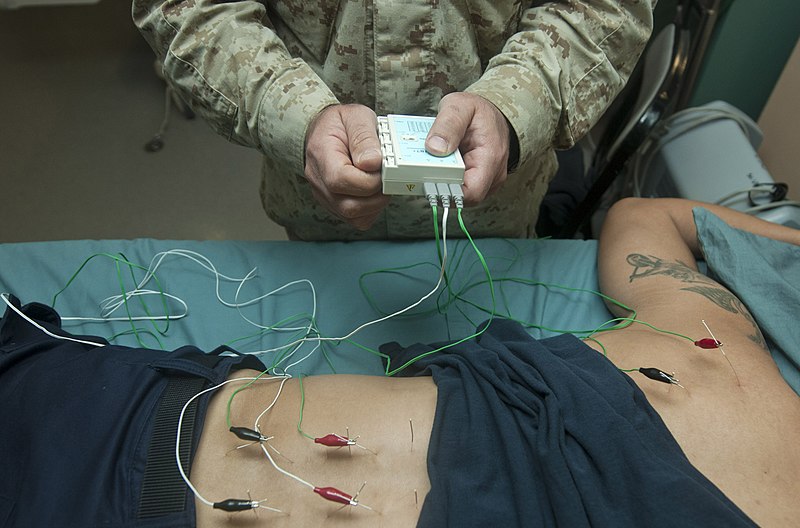Electroacupuncture hits the fan of Czech media
For the last month, the Czech media have been running sensational articles about a new polio therapy practiced by Peter Olšák, MD, at the world-famous Vesna Children’s Hospital in Janské Lázně. On February 1, Czech Radio ran the headline “Czech doctor treats paralysis with a combination of acupuncture and electrotherapy. His method is in demand abroad”. A few days later, Dr. Olšák was sitting in the Czech Television studio and talking about “his” method of electroacupuncture.
It should be noted at the outset that for some reason acupuncture has been a lege artis method in the Czech Republic since 1981 and its practitioners are associated in the Czech Medical Acupuncture Society, which operates within the Czech Medical Association of J. E. Purkyně. Acupuncture can be performed by physicians who have obtained specialisation in one of the clinical disciplines, including general medicine, and have undergone special training.
The method of electroacupuncture has been used in patients for more than five years and in children for less than three years.
Olšák called his method Active ENF, or Electroacupuncture Neuromuscular Facilitation. In it, he pricks the patient with acupuncture needles and then uses his device to deliver an electric current to the acupuncture needles. This is perceived by patients as a tingling sensation, and with greater intensity there are also visible muscle contractions.
“The current helps pathways in the body that are damaged to function better.” Did he mean meridians?

(U.S. Navy photo by Mass Communication Specialist 2nd Class Dominique Pineiro/Released)
The Board of the Czech Medical Association of J. E. Purkyně (CzMA) considers the method of “Electroacupuncture according to Voll” to be unscientific, and in 2001 and 2002 it repeatedly pressured the Acupuncture Society of the CzMA to dissolve its Electroacupuncture Section, because its existence is contrary to its mission and therefore to the Statutes of the Czech Society of Acupuncture CzMA. However, for some unknown reason, “Olšák’s electroacupuncture” seems to be in order.
Olšák continues to develop the method in cooperation with Palacký University Olomouc. Last November, a project of the Technology Agency of the Czech Republic at Palacký University Olomouc was successfully defended, in which an effective improvement of the method was reportedly developed and tested.
According to the experience so far, the treatment is said to have no side effects and shows positive results. In the journal Acupunctura Bohemo Slovaca Olšák wrote:
“A change in momentum and also in perception can be observed from the very first applications. In many cases, there are significant changes in motor skills after the first weeks of treatment. In the last year, acupuncture and electroacupuncture treatment has been used in more than 50 paediatric patients in the outpatient rehabilitation department of Olomouc University Hospital and in the Vesna children’s hospital in Janské Lázně. These were mostly patients with motor and perceptual disorders, many of them with a very serious prognosis. The effects of the applications were monitored by video documentation and clinical examination. We were able to achieve motor improvement in the majority of patients (more than 70%). In some diagnoses – e.g. central hypotonic syndrome – motor improvement is even detectable in more than 90% of children, if the patients are younger than 2 years.”
You’re thinking, “That’s great! Where can I read the study?“
Unfortunately, the doctor is not a fan of EBM or publishing in peer-reviewed journals. Instead, he gives interviews to the public media.
In February 2021, he published an article on the Homeopathic Medical Association’s website titled “The Benefits and Pitfalls of Evidence-Based Medicine (EBM)” in which we can read that we have “replaced the art of medicine with ‘hard science'” and that “a few exceptions are fields such as: psychology, rehabilitation, acupuncture, and others, although even in these branches of medicine there is an effort to move the art of healing to the fringes of the field.” He points out that “medicine is big business in Western society” and links it to BigPharma. He goes on to write about the redemptive nature of intergrative medicine and how he will not be intimidated by being told by some colleagues that he is unscientific and a quack. He concludes the article with quotes from the book The Manager and the Monk (Grün A., Zeitz J., Gott, Geld und Gewissen, 2011) and appeals for a “natural” approach in treatment.
So what are the actual results of his method? Is it possible to read about them anywhere? According to the management of the State Therapeutic Spa Janské Lázně, “Currently, there is a long-term follow-up of patients after the first application, one month and one year after electroacupuncture treatment. The results are presented regularly at professional medical congresses.”
The chairman of the Czech Skeptics’ Club Sisyfos, physician Jaromír Šrámek, commented on this in a discussion under the article on iDnes.cz “Needles under current return children to their feet, the method is being developed in the Vesna hospital”:
Somehow we have a growing mischief of “publication through press conferences”. A clinician, often not even a fraud, but just an ignoramus or a fool who perceives himself as a revolutionary or a discoverer, embarks on something extremely poorly justified, makes poor observations and announces miracles to the world, i.e. to the Czech media. Only recently it was isoprinosine, ivermectin or the MLS laser, now electroacupuncture is back on the agenda. I think that this is not a good sign of Czech academic medicine.
It should be noted that if this therapy really works, it would be a huge breakthrough in medicine. However, we remain skeptical about such a result.

Leave a Reply